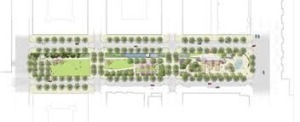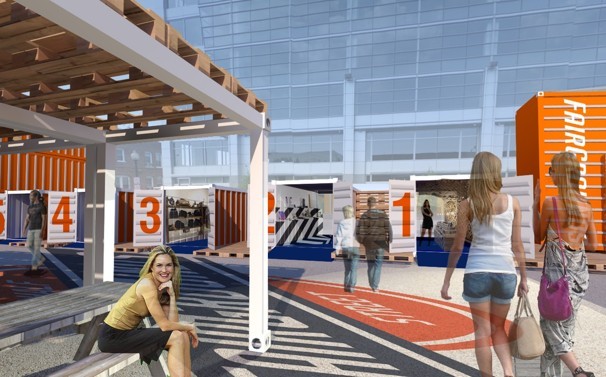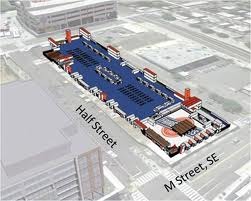Canal Park
 Monday, August 13, 2012 at 7:32AM
Monday, August 13, 2012 at 7:32AM In a previous post, I introduced some of the changes happening in the Navy Yard section of Washington, DC, specifically focusing on the temporary public space known as the Half Street Fairgrounds. I want to also highlight a permanent public space that is under construction nearby which will open in November this year—Canal Park.
Named after an actual canal that was in use in the area during the 19th century (but since filled in), this park will cover three narrow blocks that used to function as a school bus parking lot. It is a public/private partnership between the DC government and various developers to create a public space amidst new office buildings, retail, and mixed income housing. The park will include fountains, an ice skating rink, a pavilion with a restaurant/cafe, sculptures, and planned events through out the year. In addition, environmental sustainability is incorporated into the design with LEED building standards used for the pavilion, and a storm water collection and reuse system that will provide most of the water needs for the park.
One unique feature of Canal Park is its shape. Running north-south from I Street SE to M Street SE, its half block width (from 2nd Street SE to 2nd Place SE) is intersected by K and L streets, forming three rectangular blocks in a vertical line. In fact, one can call it a Linear Park based on its form, as well as the fact that this type of form is often a result of re-using a former industrial area in an urban setting. Basically, a plot of land that was hemmed in by roads or other boundaries becomes available for public use and is turned into a recreational area. With the development that has been ongoing in the area, the park will be well served by both permanent residents with new townhouses to the East, High Rise apartment buildings to the Northwest, and office and retail uses to the South and West. Providing this walkable amenity will hopefully add to the area's identity and unique qualities.
Most urban parks are either much larger areas with significant wilderness (such as Rock Creek Park or various regional ones), or they are very small pocket parks that occupy a single plot of land and do not allow as many different kinds of recreational uses. However, Canal Park is unique even compared to other linear parks in DC. Often these types of parks, such as the eleven mile Capitol Crescent Trail, "combine elements of transportation with recreation” which attracts bikers and day time hikers. Since Canal Park is only one fifth of a mile long, it serves a different function. Probably the most famous Linear Park in DC is the National Mall, but its larger scale often leaves many areas appearing empty unless there is a major event, and its relative isolation from the buildings surrounding it makes for a disconnected experience to the city as a whole. Canal Park probably has the most in common (though is much smaller in scale) with Millennium Park in Chicago in that it is focused on creating a space for people to explore and provides unique experiences. Canal Park is also designed to be more densely attended and to connect more with the urban context at its edges.
I'm excited about the opening in November and will be watching closely to see if Canal Park becomes a successful example of urban public space.
 Canal Park,
Canal Park,  Navy Yard,
Navy Yard,  linear parks
linear parks 


